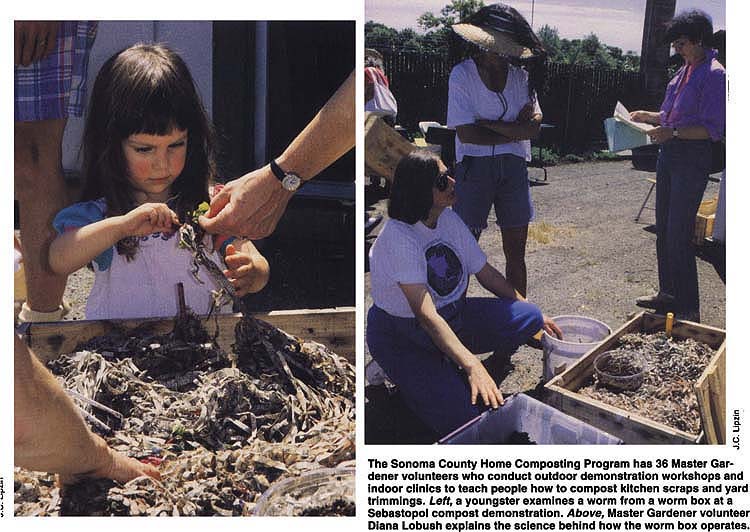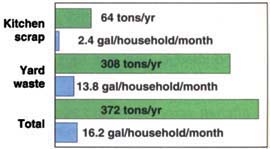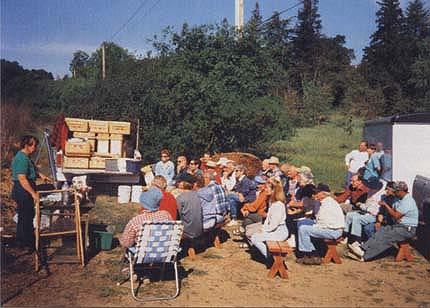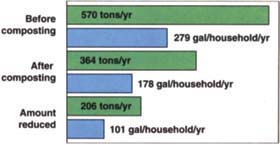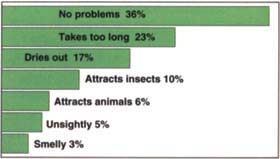All Issues
Trained home composters reduce solid waste by 18%
Publication Information
California Agriculture 50(5):11-15. https://doi.org/10.3733/ca.v050n05p11
Published September 01, 1996
Abstract
The UC Cooperative Extension's Master Gardener Program has entered into a creative partnership with the Sonoma County Waste Management Agency to help reduce landfill waste by teaching people to how to compost in their back yards. Master Gardener volunteers train approximately 1,000 people each year. A survey was conducted in 1995 and 1996 to evaluate the effectiveness of workshops and clinics. By composting kitchen scraps and yard trimmings, the home composters surveyed were able to reduce their input into the waste stream by 18.3% — about six 32-gallon garbage cans per household per year.
Full text
The Sonoma County Home Composting Program has 36 Master Gardener volunteers who conduct outdoor demonstration workshops and indoor clinics to teach people how to compost kitchen scraps and yard trimmings. Left, a youngster examines a worm from a worm box at a Sebastopol compost demonstration. Above, Master Gardener volunteer Diana Lobush explains the science behind how the worm box operates.
The average household adds 88.7 gallons of garbage to landfills each month. In response to the rapid depletion of landfill capacity and to help conserve natural resources, the California Legislature enacted AB939 in 1989. This law mandated landfill disposal reductions of 25% by 1995 and 50% by the year 2000. Sonoma County surpassed its goal of 25% reduction in 1995 and is now concentrating on reducing landfill inputs even further, according to Ken Wells, director of Sonoma County Waste Management Agency. In order to achieve 50% reduction over the second 5-year period, Wells thinks that one of the best strategies is to reduce waste at its source — by teaching people to compost in their own back yards.
Because solid waste generated by residential sources in Sonoma County is approximately 25% compostable organic products, home composting has significant waste-diversion potential. It is a simple and effective way to recycle and decrease the amount of material in the waste stream. In addition, composting lowers hauling costs for waste processing or disposal, reduces nutrient runoff at large facilities, and can integrate the household into a natural lifecycle. All it requires is some training for individual composters, which in this program is provided by volunteers. Besides helping to reduce inputs into the regional landfill, home composters reap the benefits of compost by using it as a garden soil amendment and fertilizer.
Training program
The Sonoma County program started in 1993 and was the first in the state to link UC Cooperative Extension Master Gardener volunteers and Waste Management Agency funds to teach home composting. Now in its third year, the program is a model for several other county programs teaming up with their local waste management agencies to educate potential backyard composters.
The Sonoma County Home Composting Program is funded for approximately $60,000 per year, which supports a part-time director, site manager and Master Gardener program liaison, as well as six permanent compost demonstration sites around the county (complete with shredders, active compost bins, hand tools, and storage sheds). Last year an 8-foot-by-10-foot trailer was added to service outlying communities that are not close to a permanent site. The educational program has 36 volunteer trainers who coordinate, publicize and conduct more than 40 outdoor demonstration workshops and 20 indoor clinics each year.
The Master Gardeners developed a comprehensive step-by-step training workshop that includes poster-board visuals, instructional brochures, shredder demonstrations, and proper use of compost thermometers. They also presented techniques of vermiculture (worm composting) and showed the many uses for a good, finished, compost product. At the end of each outdoor workshop, Master Gardeners and attendees built a compost pile on-site. The indoor clinics were held in local libraries and included a slide presentation and lecture on making compost at home and a demonstration of starting a worm composting box.
Survey goal and method
We wanted to find out how effective our educational efforts were with regard to participants' satisfaction with the workshops and clinics, some specifics about their subsequent composting habits and, most importantly, how much organic material was being diverted from the landfill by home composting. During the last 2 years, 1,878 people have been trained in backyard composting in Sonoma County. In 1995, survey questionnaires were mailed to 365 attendees of the workshops and clinics with 141 responses; in 1996, we sent 449 surveys and received 138 responses. The average response rate for the 2 years was 34%.
Workshop and clinic trainees were sent surveys 2 to 6 months after attending a composting class. They were asked to self-estimate their household garbage inputs of kitchen scraps and yard-waste materials in gallons or in fractions of a standard 32-gallon garbage can per week. Self-haulers (people who take their garbage directly to the landfill) were asked to self-estimate frequency and volume based on a standard (full-sized) pickup bed. We calculated the amount of waste-stream reduction based on the difference in participants' garbage input before and after they had attended a composting education session.
Landfill diversion results
In both 1995 and 1996, 68% of workshop and clinic participants indicated that they began or increased their compost pile usage after attending a Master Gardener compost training session (fig. 1). Just over 20% had already been composting and had no increase; about 10% had not composted and did not start composting. Of the 68% newly trained home composters, 50% indicated a reduction in organic material put into their garbage. Others were already composting all of the kitchen scraps and yard waste they generated, while some were composting at a negligible level, according to their own estimates of behavioral change. This means that half of the workshop and clinic participants became significant composters; their actual rate of reduction of compostable materials was twice that of the average for all workshop and clinic participants.
The quantities of organic materials diverted from the waste stream by households were very similar in both 1995 and 1996. The average amount composted for all workshop and clinic participants was 2.4 gallons of kitchen scraps and 13.8 gallons of yard waste per household per month (fig. 2). That total of 16.2 gallons per month is equivalent to 6.1 32-gallon garbage cans per household per year or, after taking into account the moisture and density of both kitchen scraps and yard waste, 372 tons total per year. Tonnage estimates are based on all trained home composters.
The average household's total landfill input per month is 88.7 gallons of garbage. Each composting household diverted 18.3% of the average household's total monthly waste stream. The total waste stream for Sonoma County — 412,530 tons buried in the landfill each year — includes a sizable amount of commercial waste products and noncompostable materials. When we compare the amount of organic waste products diverted from the landfill by backyard composters and the quantity of organic materials that are sent to the landfill by Sonoma County residents, 372 tons represents an average of 0.5% each year of the total yearly organic waste stream.
Fig. 2. Average amount of kitchen scrap and yard waste diverted from the landfill by trained home composters.
CE Offices Facilitate Community Composting Efforts
Ask any expert on recycling about the progress California has made so far, and you're likely to be told that the hardest job still lies ahead. Cities and counties are trying to meet a mandate, included in a 1989 state law (AB 939), to cut their waste by 50% by the year 2000. In some counties, Cooperative Extension is providing ample evidence that the next step is far from impossible.
Although some people have been composting for years, coordinated efforts to promote the practice are just beginning. Funding to promote the reduction of landfill waste has been available since the early 1990s from the California Integrated Waste Management Board (CIWMB) and local waste management jurisdictions set up to meet the AB 939 mandates. In many cases, educational programs were based on the results of surveys designed to determine the characteristics and quantities of the waste stream to local landfills. Many counties fund waste-reduction programs out of the landfill tipping fees charged to haulers.
Curbside pick-up programs have been active for the past 10 years, recycling newspaper, glass and aluminum. But in many communities, a large portion of the waste stream going into the landfill is made up of organic “green” waste such as grass clippings, leaves and trimmings from the agricultural and landscape industries and individual residences. In fact, yard trimmings and other organics make up an estimated 30% of California's refuse stream.
Each county has shaped its own waste management program. In some cases, a brand new Office of Waste Management has been created, in others, the programs are housed within the existing Public Works departments. In a number of counties, a joint powers authority between cities and the county funds a single waste management agency that coordinates the waste reduction efforts on a countywide basis.
A growing number of CE programs are initiating community composting programs by collaborating with their local waste management office and their Master Gardener volunteer programs.
The San Diego CE office helped the CIWMB survey CE offices statewide to determine the status of Master Gardener/Composter programs and recycling education efforts. As the state coordinating agency, CIWMB recognized the pivotal role CE offices and Master Gardener programs played in their local communities. With 36 counties responding, the survey results indicated a growing number of start-up and ongoing programs and interest in initiating a home composting/recycling program if funds become available. This led the CIWMB to fund five more CE programs in El Dorado, Napa, Placer-Nevada, Humboldt-Del Norte and San Diego counties. These programs range from taking worm boxes and curriculum materials into the classroom to organizing Master Composter trainings.
With funds provided by the local Resource Conservation District and California Coastal Conservancy and California Cut Flower Commission, San Diego farm advisors Valerie Mellano and Karen Robb produced an Agricultural Recycling Manual. It is being adapted for three other areas of the state.
In 1993, Sonoma County became the first CE office to receive a 4-year grant to coordinate a countywide effort on backyard home composting education. Implemented through a small, paid staff and core team of volunteer Master Gardeners, several workshops are conducted monthly at six community garden sites. Brochures written in English and Spanish cover everything from the compost workshop schedules to worm composting. This spring, program staff will coordinate a subsidized bin-distribution program. Staff also provide technical assistance to those just getting started. Similar programs began in Santa Clara and in Placer-Nevada counties in 1994 and early reports indicate successful beginnings. This year San Diego will be conducting a similar program.
CE offices in Calaveras, San Francisco-San Mateo, Marin, and Napa counties have partnerships with existing programs coordinated by the solid waste agencies, to provide training expertise, technical assistance and educational materials.
Public education efforts are underway nationally to reduce the amount of waste going into our landfills. In a national survey conducted by Cooperative Extension at the University of Wisconsin in 1994, some of the most effective program elements cited were Master Composter training, educational workshops and subsidized bin distribution. Research is currently being conducted to determine the cost benefits of backyard composting as a method of waste reduction. A study funded by US EPA and the Composting Council Research & Education Foundation will formulate national estimates of waste diversion and cost savings. But preliminary findings offer a very positive sketch of backyard composting's economic value. The study surveys programs across the country that have kept detailed records. On average, home composting programs spent $12 for every ton diverted in 1993–94 and 1994–95.
Where possible, matching Master Gardeners and CE office priorities with local public-policy mandates and public need for research-based information provides the perfect union, especially when the mandate is accompanied by funding. The real benefits to the county-based program is the provision of long-term funding (at least through 2000), a solid county partnership, and most importantly, the accomplishment of an important local, state and national mandate.
Master Gardener Cynthia DeMartini demonstrates composting techniques at the Pauline Bond Community Farm in Sonoma.
Another service offered by the Waste Management Agency is the biweekly curbside collection of organic yard waste, which is then transported to a regional composting facility. Huge compost piles are made after sorting and grinding the raw materials. The finished compost is sold to gardeners and farmers in the area. Workshop and clinic participants were surveyed in 1996 about their estimated use of this service. We found that they reduced the amount of materials put out for pick up and transport to the regional facility by 206 tons per year or 101 gallons per household per year by composting it at home (fig. 3).
Home composting is saving the cost of collecting, hauling, and dumping fees for raw materials to a landfill, an estimated cost savings of $135 per ton or $78,030 per year. Difficult-to-quantify savings include the reduction in traffic and air pollution from garbage trucks; less need for landfill or centralized composting facility space; and less need for distribution of finished compost to end users.
Public outreach
The best method of publicizing training workshops and clinics was via the local newspaper, which publishes an announcement in the gardening section each Saturday. Over 40% of attendees learned about the training from the paper, followed by 27% from other Master Gardener clinics and fairs, and about 20% from flyers placed in garden and hardware stores.
Workshop organizers found that it takes considerable effort to publicize and attract participants. Average attendance in 1995 was 11 people per session; in 1996 it was 28 — which was due to incentive programs at the clinics and workshops that gave away finished compost and sold composting bins at wholesale prices. Other publicity included hand distribution of flyers at gardening stores and events by volunteers, as well as feature articles and listings in the calendar-of-events section of the local newspaper. Volunteers also reached many people who did not attend workshops or clinics by distributing 41,000 educational composting brochures over a 2-year period at farmers' markets, country and harvest fairs, garden clubs, nurseries and garden centers and by mail.
Participants gave workshops and clinics very high ratings. There was strong agreement that the training was well organized, useful, inspirational, and worth recommending to others.
Composting techniques
Trained home composters reported using similar types of materials such as leaves, grass clippings, kitchen scraps and plant prunings for their compost. One-third to one-half of the survey respondents use open compost piles, while 25% have worm boxes. Only 17% use a plastic bin enclosure, although 18% more indicated a desire to have and use one.
Nearly 40% of workshop and clinic participants are looking for help in chipping woody plant materials and would compost even more if there were some type of chipping service. One-fifth also indicated a desire for different sources of compostables, such as manures and green material to mix with their yard waste and kitchen scraps. In 1996, Master Gardener trainers offered to chip attendees' brush when brought to one of the workshop sites; however, because the organic materials are bulky and difficult to load and unload, very few people used the service.
Almost 80% of home composters in 1995 and 50% in 1996 experienced some problems with their compost piles or worm boxes. Most composting difficulties involve “Mother Nature,” such as piles drying out or taking too long to finish (fig. 4). (These two common examples may even be related, since dry organic materials do not compost rapidly.) The training program workshops and clinics teach methods for manipulating moisture content and address composters' expectations about the length of time necessary to make compost. Composting is new to three-fourths of the home composters, however, and they are likely to solve such problems through experience.
The attraction of animals and insects to compost piles and worm boxes was indicated by 16% of the respondents. These pests could be a major deterrent unless home composters use enclosed systems and locate their compost piles where they won't interfere with residential comfort. Very few respondents said that the compost piles or worm boxes were unsightly, smelly, or that any of the problems experienced would stop them from composting.
These sturdy instructional posters have been copied for use in Placer-Nevada and Napa counties' workshops.
Conclusions and discussion
The cost of providing training for each person who attended a composting workshop or clinic was approximately $60. Many other people were given information through educational brochures and individual consultations with Master Gardeners. This investment in time and money was made in hopes of prompting lifestyle changes so that people will continue to compost, recycle and reduce their solid waste output. The rate of diversion per trained composter household is very high, with some composting all of their kitchen scraps and yard waste, and the average reducing their waste stream input more than 18% per month. This is impressive because the total waste stream includes over 75% noncompostable materials.
The program also has an undocumented cumulative effect since many composters will share information with their neighbors and continue to compost for many years beyond the workshop they attended. Over 93% of workshop and clinic participants indicated that the compost training was worth recommending to others. As more people begin to compost, the overall effect of their composting efforts will be to significantly reduce landfill inputs at a reasonable cost to the waste management agency.
Most people who attend the composting workshops or clinics become motivated to do some composting. While those new to composting experience problems common to the composting process, these problems can be overcome easily with additional experience and information. The main limitations to home composting by the general public seem to be attitude toward the environment and the willingness to take time to separate organic materials from the garbage. Most households have plenty of room for a 3-foot-by-3-foot compost pile, or worm box for apartment dwellers. Like gardening, home composting can be enjoyable and can become an integral part of gardening and living in a highly urbanized state. Composting makes people feel good about the positive reuse of a valuable resource.
The Waste Management Agency and the Master Gardener Program have formed a unique partnership that benefits the community. The Master Gardener Program is able to obtain program coordination funds and the Waste Management Agency can reach more people — with an effective, high-quality educational program taught by volunteers — with little expense.
This educational program strongly depends on Master Gardener volunteers to lead workshops and clinics. Master Gardeners are trained UC volunteers who donate their time to help home gardeners and composters. These volunteers are motivated by a range of factors that include the connection between gardening, composting and the environment; a desire to help others; satisfaction from teaching; and a sense of community purpose. In California, there are currently 31 county-based programs and over 2,000 active Master Gardener volunteers. Sonoma County had 168 active Master Gardeners in 1996.
As our population increases, as resources decrease and landfills reach capacity, the creative partnership forged between UC Cooperative Extension and the Waste Management Agency to teach residents to compost at home will have a significant, long-term beneficial impact by diverting thousands of tons of organic material from landfills.



